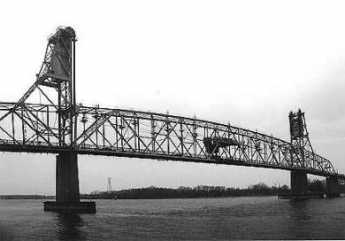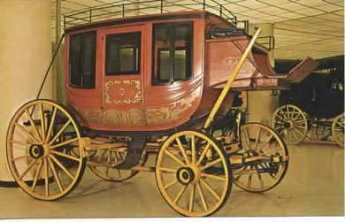Related Topics
Quakers: William Penn
Although Ben Franklin gets more ink lately, William Penn deserves at least equal rank among the most remarkable men who ever lived.
City of Rivers and Rivulets
Philadelphia has always been defined by the waters that surround it.
Sights to See: The Outer Ring
There are many interesting places to visit in the exurban ring beyond Philadelphia, linked to the city by history rather than commerce.
Historical Motor Excursion North of Philadelphia
The narrow waist of New Jersey was the upper border of William Penn's vast land holdings, and the outer edge of Quaker influence. In 1776-77, Lord Howe made this strip the main highway of his attempt to subjugate the Colonies.
Montgomery and Bucks Counties
The Philadelphia metropolitan region has five Pennsylvania counties, four New Jersey counties, one northern county in the state of Delaware. Here are the four Pennsylvania suburban ones.
Bristol, PA

|
| Burlington Bristol Bridge |
In 1681, Samuel Clift activated a local land conveyance, written to go into effect as soon as King Charles II signed the overall land grant to William Penn. In this way, Bristol claims to be the oldest settlement in English Pennsylvania; Clift got here before Penn did. He chose the narrowest spot in the river as an excellent place to run a ferry which was only replaced by the Burlington Bristol Bridge in 1930. A ferry landing is an excellent place for an Inn, which he also built there. The town he founded was called Buckingham, and the surrounding county became Buckinghamshire, Bucks for short. The name later changed to Bristol. The New Jersey town on the other end of the ferry ride was called Bridlington, later Burlington. North of this narrow spot in the river was a several-mile extent of marsh and swampy inlets, and then the river turns abruptly northwest at what used to be called the falls at Trenton.
William Penn had considered building his house sixty miles south of there at the Southern end of Philadelphia Bay, at Chester, then pondered building it on the Faire Mount where the Philadelphia Art Museum now overlooks the Schuylkill. In the end, he built a Philadelphia house near Dock Creek (subsequently covered over and renamed Dock Street) and a palatial manor house, Pennsbury, in the swampy marshes above Bristol, where a tourist visit is now a valuable experience.

|
| Stagecoach |
No doubt being near the Proprietor's estate gave Bristol some class, but it was also half-way on a two-day stagecoach ride from Philadelphia to New York. A succession of inns and resorts grew up in Bristol, and it became a busy transshipment place, a good place to build schooners. A local Captain John Cleve Green is celebrated as first to carry the American flag to China, although it must be admitted his cargo included opium; Green is regarded as the financial founder of the nearby Lawrenceville School. The terminus of the Delaware canal brought coal from the anthracite region in 1827; more prosperity ensued as coal was loaded on ships in Delaware, or utilized instead of water power for the Bristol Mills which had been founded by Samuel Carpenter in 1701. John Fitch invented the first steamboat and tried it out here; more prosperity ensued, although not for poor Fitch, who committed suicide. Little Bristol gradually filled up with imposing waterfront mansions, the declining shells of which can still be admired.

|
| Bristol Railroad |
The advent of the railroad isolated Bristol when it cut off the corner of the bend in the Delaware River. Four-lane highways eventually consolidated the isolation of the little river town, but the turning point was around the time of the Civil War. For nearly a century, between the Revolution and the Civil War, Bristol was the booming little queen of northern Philadelphia Bay, and the Bay itself was an American Lake Como, lined with Federalist and Victorian mansions, their lawns sweeping down to the water's edge. Small wonder there was so much social interaction between the railroad-isolated Bristol, and planters of Chesapeake Bay. The strip of quiet charm begins at Pennsbury Manor and pretty continuously extends to Bristol, where you can go under the rail embankment and on to Philadelphia, or alternatively cross the Burlington Bristol Bridge to New Jersey. A couple of miles further south, the river edge is a little ragged but includes some yacht clubs and several famous mansions, notably Nicholas Biddle's Andalusia, the Foerderer family's Glen Ford, and the former mansion of Saint Katherine Drexel.
The Bristol area has had moments of fame. George Washington had originally planned to attack Trenton from both the north and the south simultaneously. He came over what is now called Washington's Crossing amid the ice floes on the north side of the Pennsbury delta, and General Cadwalader was to cross Delaware at Bristol, on the south side of the marshes. As it turned out, the ice was worse at Bristol and the river wider, so Cadwalader was late for Trenton but caught up with Washington to help with the battle at Princeton. President Tyler's daughter married a dashing gentleman from Bristol. Republican politicians from Bristol teamed up with some others in West Chester to decide that favorite-son Seward couldn't win, so they backed Abraham Lincoln for the presidential nomination, and Pennsylvania was therefore in time richly rewarded for its political acumen. Despite the arts and crafts group that moved in around New Hope PA, Bucks County has remained a Republican stronghold ever since. The region's influence was long symbolized by Joseph P. Grundy, the gentle Quaker manufacturer from Bristol whose name struck terror in Republican politicians as well as Democrat ones, but for opposite reasons.
The Burlington Bristol Bridge is now getting a little narrow and ancient, but is still serviceable. It long charged only a dime's toll because that was enough for painting and upkeep. Together with the Tacony Palmyra Bridge, which charged the same low toll, these locally owned bridges stuck a thumb in the eye of the tax-and-spend folks who owned the Philadelphia bridges and who wanted to charge three dollars toll, spending most of it on non-bridge activities. As Tacony Palmyra Bridge rests on both sides of the river, the local politics gradually shifted enough to permit a restoration of toll "equity".
Originally published: Friday, June 23, 2006; most-recently modified: Wednesday, May 22, 2019
| Posted by: matt kosman | Aug 9, 2009 12:56 PM |
I found this be entertaining and informative.
Though I believe Cadwalader made his attempt at Dunk's Ferry, in Bensalem.
You if revising mention the seaplane terminal, and factory, up near Radclife and Green.
| Posted by: Richard Karpinski | Dec 25, 2007 6:25 PM |